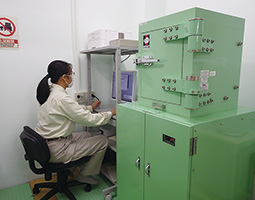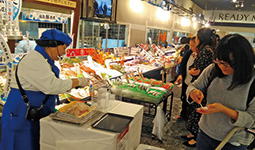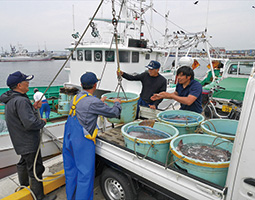Home > Highlighting JAPAN > Highlighting Japan October 2019 > Policy-Related News
Highlighting JAPAN
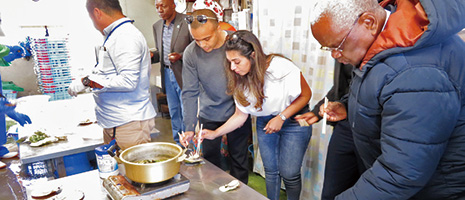
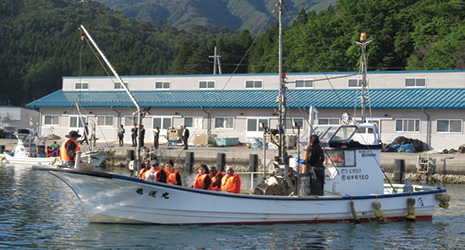
Safe and Delicious Tohoku Fish
Some fishery products from the Tohoku region including Fukushima Prefecture had been subjected to distribution restrictions due to the Fukushima Daiichi Nuclear Power Station accident. However, fishery products that have undergone stringent inspections are now being distributed to the market.
The waters off Fukushima Prefecture are at the confluence of two ocean currents, the Oyashio from the north (Tsushima current) and the Kuroshio from the south (Japan current), so the area is known as Shiome no Umi (the point where two ocean currents meet). An abundance of plankton provide nutrients for fish that live in both warm and cold currents, enriching these fishing grounds. The fish caught in this area is known as joban-mono, a term synonymous with flavorful fish.
However, radioactive materials were released from the Fukushima Daiichi Nuclear Power Station by the tsunami caused by the Great East Japan Earthquake in March 2011. Immediately following the nuclear power station accident, the government, relevant prefectural governments, and fisheries-related organizations began collaborating in an effort to ensure the safety of fishery products by conducting monitoring inspections of radioactive cesium in fishery products, mainly in Eastern Japan including Fukushima Prefecture.
In April 2012, the standard limit of radioactive cesium in foods was revised from 500 Bq/kg to 100 Bq/kg and also applied to fishery products. This limit is stricter than the 1,000 Bq/kg adopted by the Codex Alimentarius Commission that establishes international food standards.
The scheme for monitoring inspections of fishery products was developed by local governments, and determines the target species, inspection frequency and monitoring areas. Monitoring inspections are normally conducted on a weekly basis, focusing on major commercial species and species that exceeded 50 Bq/kg in the previous year. For species exceeding the standard limit, distribution restrictions are issued by the Nuclear Emergency Response Headquarters (whose director-general is the Prime Minister), with the lot containing the same species from the same areas recovered and not distributed to the market. Fish species and areas that exceed the standard limits are subjected to strengthened monitoring inspections. When the inspection results are consistently below the standard limit, then the distribution restrictions are lifted. In addition to the above-mentioned prefectural monitoring inspections, the Fukushima Prefectural Federation of Fisheries Co-operative Association (JF Fukushima Gyoren) is voluntarily conducting inspections in accordance with the government’s screening methods. The voluntary standard limit established by JF Fukushima Gyoren (50 Bq/kg) is stricter than that established by the government. Moreover, the prefecture requires a detailed inspection to be conducted if the level detected at the screening inspection exceeds 25 Bq/kg. If the level detected at the detailed inspection or the prefectural monitoring inspection exceeds the voluntary standard limit, the prefecture refrains from distributing the fishery products. All of these results are published on the websites of the Fisheries Agency, local governments, and relevant fishery associations.
Ensuring Safety
Immediately after the nuclear power station accident, approximately 122,000 fishery products (marine species) were subjected to monitoring inspection up to August 31, 2019, mainly in Eastern Japan including Fukushima Prefecture. Immediately after the nuclear power station accident, around 21% of those samples exceeded 100 Bq/kg. Since then, however, the number of samples that exceed the standard limit has decreased with the passage of time. One sample exceeding the standard limit detected recently in Fukushima Prefecture for the first time after three years and ten months of no such cases in marine fish species (as of January 2019).
The concentration of radioactive material has also decreased over time. As of August 31, 2019, two marine fish species caught in the coastal waters off Fukushima are subject to distribution restrictions.
The volume of landed fishery products in Fukushima Prefecture is gradually returning to normal, with the volume of fish being distributed both within and outside the prefecture increasing. Various initiatives have been implemented to boost this trend. One such initiative is a collaborative venture by Fukushima Prefecture, JF Fukushima Gyoren and AEON Retail, AEON’s supermarket operator, opening a permanent section in ten AEON stores in the metropolitan area and Miyagi Prefecture for the sale of fish caught in the coastal and offshore areas of Fukushima Prefecture such as skipjack tuna, Pacific saury and flounder under the “Fukushima Sengyo-bin” (Fukushima Fresh Fish Service) brand. Manned by a dedicated salesperson who communicates the appeal of the products to consumers face-to-face, the initiative has been very popular.
Iwaki City on the southern coast of Fukushima Prefecture works to promote the attractiveness of the local “Joban-mono” brand through activities engaging all involved in the city’s fisheries industry such as designing a logo and managing a website. This cooperative initiative has been highly evaluated by those working in the fish market.
Evaluation by International Institutions
The monitoring inspection team dispatched by the International Atomic Energy Agency (IAEA) from November to December 2013 is credited with ensuring the safety of marine products distributed to the market through measures such as establishing the standard limit for radioactive materials in marine products, comprehensive monitoring of seawater and distributed food, and distribution restrictions. In addition, in November 2015 and November 2016, the IAEA conducted an interlaboratory comparison of the measurement of radioactive materials in fishery products with the aim of confirming the appropriateness of the method for measuring radioactive materials in fishery products in Japan. The comparison confirmed high accuracy and competency on the part of participating Japanese laboratories in respect of the analysis of marine products for radioactive materials.
© 2009 Cabinet Office, Government of Japan
